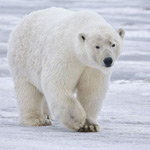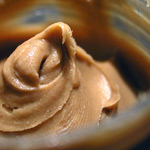It's easy to memorize facts about the carbon cycle. It is difficult to put those facts together to come up with explanations. It might be tough at first but by the time you're done you should be able to tell how carbon in peanut butter can end up being a part of a cell in a polar bear.
Hints:
- Living things (past and present) all contain carbon.
- When plants or animals die they can become part of the soil.
- Decomposers can eat the plants or animals and produce carbon dioxide.
- Carbon dioxide gas in the atmosphere can be used by plants to grow.
- Animals can eat plants (or eat other animals that eat plants).
How can a carbon atom from a polar bear end up in peanut butter?
 Source: Wikimedia Commons |
 |
 Source: Wikimedia Commons |
We'll skip the unlikely event of a polar bear wandering into a peanut field.
As the polar bear digests a recent meal, nutrients enter her bloodstream and are delivered to the cells. Oxygen enters the polar bear's lungs and also enters the bloodstream and is delivered to cells. The cells use the nutrients from food and the oxygen from the air to generate energy and give off carbon dioxide. The polar bear's lungs remove the CO2 and the polar bear breathes it into the air.
The carbon dioxide enters the atmosphere and is moved around by winds. Eventually the CO2 molecule reaches a peanut plant. The plant uses sunlight to create food from the carbon. O2 is released into the atmosphere. A farmer harvests the peanut and it is sent to the factory to make peanut butter.
The carbon atom that started out in the polar bear is now in your peanut butter. It is likely that most jars of peanut butter have several atoms of carbon that were once part of a polar bear.
How can a carbon atom from a dinosaur end up in an iPod?
 Source: Wikimedia Commons |
 |
 Source: Matthieu Riegler, Wikimedia Commons |
Long ago, the dinosaurs roamed the earth eating plants or other animals. Perhaps the dinosaur died and was buried along with plant matter. Eventually the carbon in the dinosaur's body became part of a deposit of hydrocarbons.
Millions of years later, humans began drilling oil wells to get to the rich deposits of hydrocarbons. They then separated them into fuels for energy and materials to make other substances like plastic.
Using hydrocarbons from the oil well, humans made plastics. Some of those plastics were then shaped into the body of an iPod.
There are other paths the carbon atoms could take in the carbon cycle than those described in the examples above. The key thing to understand is that carbons atoms can be transformed and moved around the earth.
Can you figure out how a carbon atom could get from the bubbles in your soda to a plant in China?





